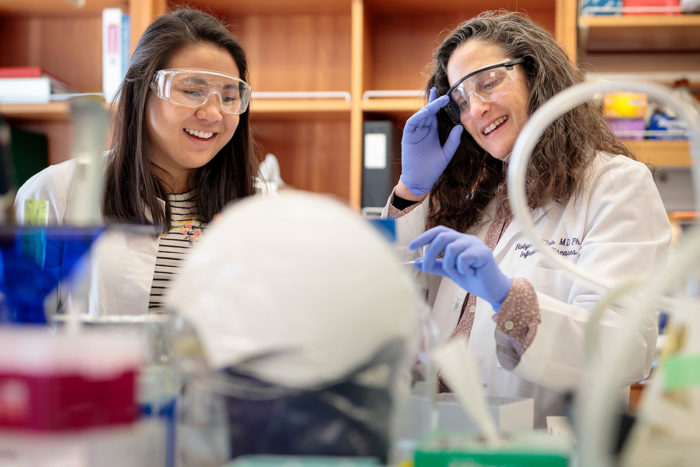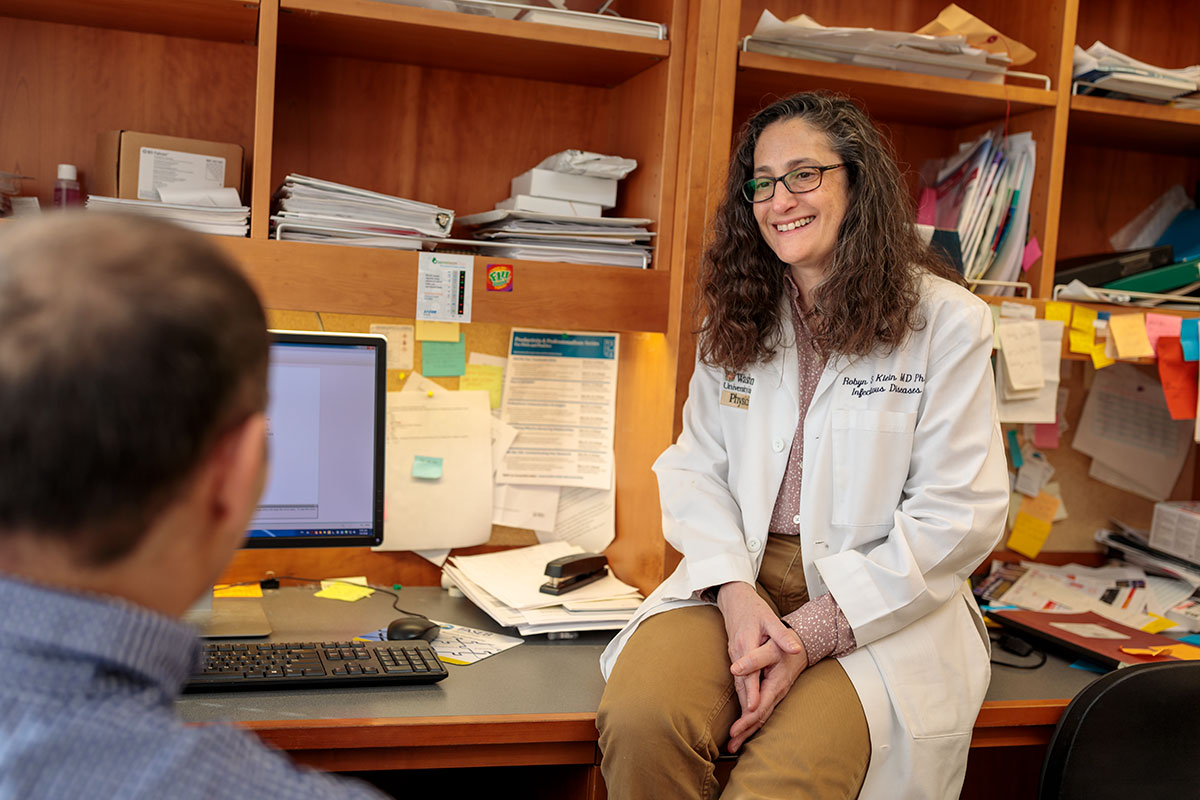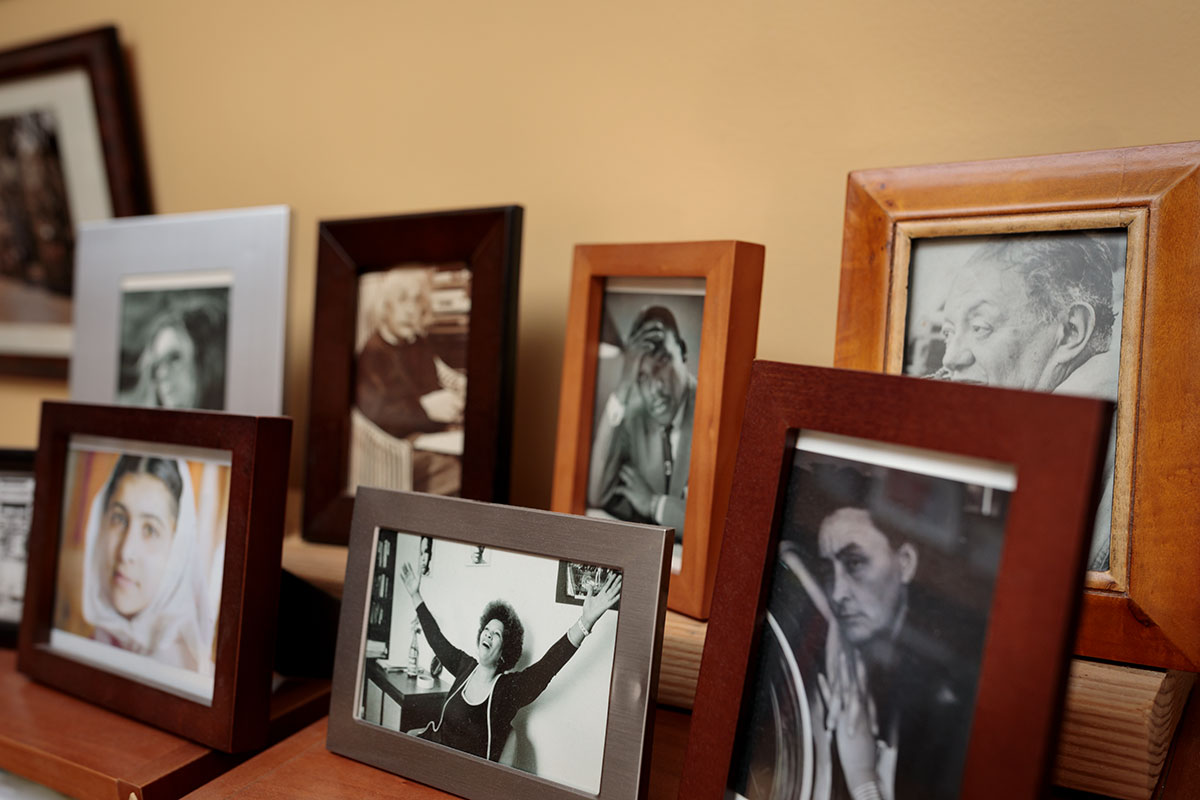Washington People: Robyn Klein
Neuroimmunologist promotes diversity in science
 Matt Miller
Matt MillerRobyn Klein (right) shares a laugh in the lab with graduate student Allison Soung.
In 2016, as Robyn Klein, MD, PhD, and Jessica Williams, PhD, then a postdoctoral fellow in Klein’s lab, looked over the program for an upcoming international neuroimmunology meeting they were planning to attend, one thing jumped out at them: Only 13 of the 85 invited speakers were women.
“Robyn told me later that she just couldn’t get past the look on my face when I saw how few women there were,” Williams said. “So within the next week, she decided to take a stand.”
Klein, vice provost and associate dean for graduate education for the Division of Biology & Biomedical Sciences at Washington University in St. Louis, emailed the organizers to demand an explanation. One wrote back to say that there simply weren’t as many accomplished women.
“That really got to her,” said Anne Cross, MD, a professor of neurology and a longtime collaborator of Klein’s. “So she contacted all of her friends in neuroimmunology – men and women – and came up with a game plan to figure out whether there aren’t as many qualified women as men in the field. And she showed, pretty conclusively, that it wasn’t true.”
Her findings prodded the conference organizers to double the number of female speakers. Klein continued to investigate, eventually publishing a paper in Nature Immunology showing accomplished female scientists are routinely overlooked by neuroimmunology conference organizers worldwide.
It was the latest skirmish in Klein’s lifelong battle against the idea that women don’t belong in science. Today, she is a recognized expert on the brain’s immune system, and a founder and director of the university’s Center for Neuroimmunology and Neuroinfectious Diseases. But at one time, she was a bright kid growing up in a family and a community where she was told that girls didn’t do science.
 Matt Miller
Matt Miller“It was difficult for me to decide to become a scientist, because I had been raised to believe that science wasn’t a suitable path for me,” said Klein, a professor of medicine, of pathology and immunology, and of neuroscience. “I had very negative interactions with some male science teachers in school. My family made it clear that it would be more appropriate for me to pursue some of my other interests, like writing.”
Klein, who grew up in New Rochelle, N.Y., just north of New York City, felt hemmed in by such ideas. When she heard, while still in middle school, that Barnard College was hosting an informational session at her high school, she hopped on her bike and rode over. The all-women’s school in New York City was well-known in Klein’s hometown.
“I went running up the stairs and ran in and said, ‘What do I need to do to get in to this school?’” Klein recalled. “And they said, ‘How old are you?’ But then they told me everything I had to do, and over the next few years I did it. Even then, I knew that I needed to go to a women’s college, where I could unlearn these ideas I was hearing from everyone. I knew they were wrong. They were wrong about me, and they were wrong about the world.”
The go-getter attitude that set her on the path to Barnard at age 14 has served her well throughout her career. She developed an educational path for herself in neuroimmunology – a PhD in neuroscience, followed by a residency in internal medicine, where she learned about the immune system, and a fellowship in infectious diseases – at a time when the field itself was just emerging and no clear training path existed for interested young physician-scientists.
When Klein was in medical school at Albert Einstein College of Medicine, conventional wisdom held that the immune system steered clear of the brain. The blood-brain barrier was sufficient to keep microbes and toxins out, she was told, and immune cells in the brain were a bad sign, a marker of the neurological disease multiple sclerosis.
“When I started on the medical wards as a medical student, it was in the middle of the HIV epidemic in New York City,” Klein said. “So many of our patients were young people dying of AIDS, and a lot of them had infections of the brain.”
As she made her rounds treating people whose immune systems had been decimated by AIDS and brains ravaged by other opportunistic infections, she realized that a healthy immune system must be a crucial part of the brain’s defenses. But to her surprise, very little work was being done on how the immune system protects the brain under normal conditions.
So she tackled the question herself. For her postdoctoral training she chose an immunology lab and began studying HIV infection of the central nervous system. Not long after she started, though, a bombshell paper came out reporting the discovery of a second receptor that HIV uses to get inside cells. The primary receptor had been discovered years before, and its location on immune cells explained why the virus destroyed one branch of the immune system. Now a secondary receptor had been found. But what did it mean?
Klein had a hunch. The secondary receptor was the docking site for immune messenger molecules known as chemokines. Many neurons had similar docking sites, she knew.
“I thought these receptors had to be all over the brain,” Klein said. “I said to myself, ‘This must be the link between the nervous system and the immune system.’”
As it happened, her husband, Joshua Rubin, MD, PhD, now a professor of pediatrics at the School of Medicine, was doing his postdoctoral fellowship in a neurology lab that studied such chemokine docking sites. He faxed her a protocol for growing neurons, Klein switched labs to one that focused on chemokines, and the two began to study how chemokines affect neurons, much to the bemusement of their mentors. The idea that immune messenger molecules might influence the behavior of neurons boggled the minds of both immunologists and neurologists.
“Soon we had a paper, and we put it together and showed it to our mentors, and they said, ‘We don’t even know what you’re doing,’ ” Klein said.
Published in the journal Development in 2001, the paper showed that chemokines influenced the ability of developing neurons to multiply and migrate, indicating that the immune system plays an important role in the normal behavior of the nervous system. The paper has been cited hundreds of times.
Klein and Rubin had not collaborated on a paper before, even though they had been working in related fields since they met in a graduate neuroscience class a decade before. He was older than her but a year behind her in their MD/PhD program, as he had spent five years after college playing Irish folk music professionally.
The two have been together more than 20 years. They are raising two daughters, Nisha, 18, and Sophia, 13, in an old house in Webster Groves. They have furnished their home with antiques discovered at stores all over St. Louis and further afield. An exquisite green Roseville basin on a pedestal is one of their most prized finds.
 Courtesy of Robyn Klein
Courtesy of Robyn KleinTo her daughters, Klein is more the absentminded professor than the brilliant scientist. She has been known to wear her bike helmet backwards. She sometimes forgets what her car looks like, mistakenly wandering over to a stranger’s car as the girls watch and laugh.
“I’ve always done things like that,” Klein said. “My family used to tease me about it when I was growing up, and now my daughters make fun of me. It’s because I’ve got something else I’m thinking about, some problem I’m processing.”
Much of the time, the problem she is processing has to do with how immune cells get through the blood-brain barrier to enter the brain, and their effect on brain cells once they arrive. In recent years, she has been untangling the destructive role of the immune system in brain infections caused by West Nile virus. Her work suggests that out-of-control inflammation could explain why some people struggle with memory loss long after the virus is cleared.
“Robyn has a remarkable ability to apply an interdisciplinary approach across multiple fields – neurology, immunology, microbiology,” said Michael S. Diamond, MD, PhD, the Herbert S. Gasser Professor of Medicine. Diamond advocated for recruiting Klein to the School of Medicine in 2003.
“We recruited her because she was an excellent scientist who was working on questions of neuroinflammation in the context of multiple sclerosis, and we were hoping she also would begin to look at viral infections in the brain, which she has,” Diamond said. “She’s been an outstanding colleague. She’s broadened our science and allowed us to tackle key questions that we would not have been able to answer without her.”
Klein herself will tell you that she’s had many mentors who’ve smoothed her path to success, starting with a middle school biology teacher with whom she’s still in touch. In her role with DBBS, she is now in a position to return that favor for a whole generation of young scientists. She is working on initiatives to help graduate students learn about scientific career options outside of academia. And she takes care to address the special hurdles that face women and underrepresented minorities in the sciences.
 Matt Miller
Matt Miller“Improving diversity requires deep service,” Klein said. “You have to put your heart into it and know that it’s right because overlooking women and minorities reduces excellence and impact. If you want to capture all the talents of humanity you have to include all of humanity.”
To Cross, Klein’s legacy of encouraging young scientists of diverse backgrounds may be as important as her scientific contributions.
“She’s always been very adamant about involving young people and women and minorities, giving them a chance to shine,” Cross said. “There’s something called ‘stereotype threat,’ when people are interested in a career but they see that they don’t fit into the stereotype for that career, and it discourages them. That’s why it’s important to see someone like themselves up on stage. She’s taken on that issue with a go-get-it attitude, and I think she’s really done some good.”






